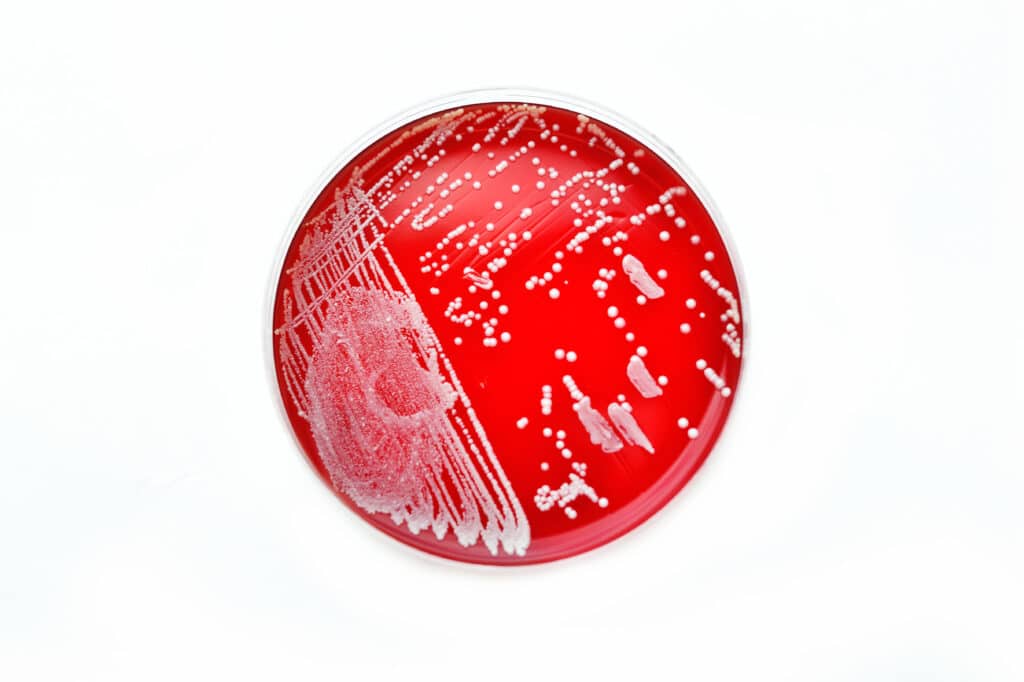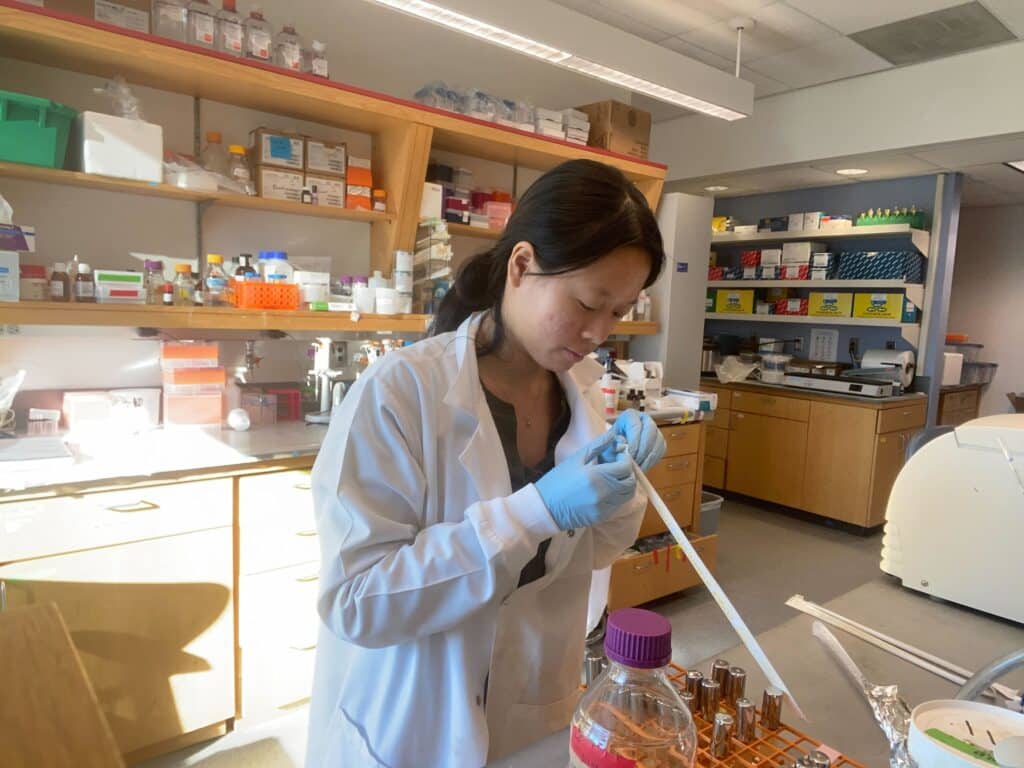Bacteria vs. Plastic
By Claire Andreasen
An interdisciplinary Duke team harnesses the destructive powers of bacteria to break down plastics in the environment

Researchers predict a startling future: By 2050, plastics in our oceans could outweigh fish. As plastic production continues to increase and trash collection systems continue to falter, plastic negatively impacts marine biodiversity and human health. Every week the average person consumes approximately five grams of microplastics, each gram laden with potentially cancer-causing additives. Amidst growing concerns about the impacts of plastic pollution on both public health and the environment, an interdisciplinary Duke team is researching bacteria with the potential to break down these synthetic materials.
The team is part of Bass Connections, a university-wide Duke program that gives students a chance to apply classroom lessons to complex societal challenges, working alongside faculty from all of Duke’s schools.
Jason Somarelli, professor of medical oncology, and Will Eward, orthopedic oncologist, conceived the idea of forming a Bass Connections team to address plastic pollution after coming across an article about a newly identified strain of plastic-degrading bacterium. “Will and I were growing increasingly concerned about plastic in the environment and so were our colleagues,” said Somarelli, who has worked as a team leader on the Bass Connections project —”Bioremediation of Plastic Pollution to Conserve Biodiversity”— for more than five years now.
Over the years, the group has worked to both uncover the health consequences associated with plastic additives and discover faster ways to degrade plastics using bacteria. The project has three main sub-teams: bioremediation, human health, and bioinformatics.

Sage Hirschfeld is a third-year environmental engineering major and a researcher on the bioremediation sub-team that works to accelerate plastic degradation via bacteria. Hirschfeld has worked primarily on combining cut190, an enzyme capable of degrading PET (Polyethylene terephthalate) plastics, with a bacteria called Thermus thermophilus that can degrade plastics at higher temperatures. This is useful because plastic is easier to degrade when it’s heated up.
“The idea is that we can degrade plastic more efficiently if we heat it up to the point where it starts to lose its structure, which is called its glass transition temperature,” Hirschfeld noted. “At the end of last year, I was finally able to get the gene into that bacteria and see that it was working, which was so exciting.”
Ashley Huang, a second-year environmental engineer who recently joined the bioremediation group, is helping build a device that can cut plastic into smaller pieces that bacteria can more readily digest. The device will be useful as they test Pseudomonas stutzeri bacteria, a strain that the lab previously showed to have degrading properties, on more complex plastic polymers such as PET. “PET plastic, which is commonly used, is pretty complex, so we’re seeing how far we can push the P. stutzeri,” said Huang.

On the bioinformatics sub-team, students use computational skills to analyze which bacteria may exhibit degrading properties and which plastic additives may be carcinogenic. This analysis is often the basis of further wet lab research performed by the other sub-teams. As Cadmus Yeo, a graduate biomedical engineering student noted, “On the bioremediation side, a lot of the systems we plan to manipulate have gotten to us because the bioinformatics team has done the computational groundwork.”
For instance, last year the bioinformatics sub-team was able to map the structure of the proteins responsible for PET degradation and then scan the other strains of bacteria for similar structures. They found that a soil bacterium, Pseudomonas stutzeri, contained two plastic-degrading enzymes, PETase and MHETase. “Our bioremediation team was then able to get that bacteria and validate that result,” Hirschfeld explained.
The bioinformatics team also works to uncover which plastic additives — materials added to plastics to improve performance —might be harmful to human health. The team accomplishes this by extracting gene expression information from databases and comparing it to the characteristics of known carcinogenic additives to find possible matches. Last year, they performed a toxicogenomic analysis on 2,712 additives, discovering more than 150 additives with carcinogenic potential.
On the health team, project members test polymers with plastic additives on live cell cultures. They do this by creating sample plastics containing potentially harmful additives, exposing them to cell cultures, and then looking at cell viability, DNA damage, and gene expression markers that are related to cancer.
Bea Schleupner, a team leader and lab manager who joined the group as an undergraduate, explained how the lab tries to generate sample plastics that are representative of what is actually found in the environment.
“A lot of existing research on human health and plastics looks at one polymer, one additive, or perfectly spherical pieces. We’re trying to use this system to make a more realistic version of what plastic exposure is like.”
Bea Schleupner, Team Leader
The project’s multifaceted focus requires a highly interdisciplinary team, which is the hallmark of the Bass Connections program. This year’s team consists of three graduate students from the Departments of Biomedical Engineering and Ecology as well as six undergraduate students from the Departments of Environmental Engineering, Computer Science, and Biology. “I think what is most impressive is that all these people come from really diverse disciplines and are yet all so interested in biological sciences and biological engineering,” said Yeo.
Schleupner was initially drawn to the project because of its multidisciplinary focus. “I found that this project was looking at a really cool intersection of environmental issues and human health,” Schleupner said. Indeed, some of the most effective environmental legislation has historically come after we realized the health implications of pollutants; as Schleupner pointed out, the Montreal Protocol (a treaty that banned ozone-depleting chemicals) was drafted after research revealed that a thinning ozone layer would increase the risk of skin cancer in humans. “If we can show people evidence that plastic is harmful in the long run, that will provide more of an impetus for people to act on plastic pollution,” Schleupner said.
Somarelli said the goal of the Bass Connections team is to equip talented students with all the tools they need to go on and solve big problems. Undergraduates like Hirschfeld and Schleupner describe the team as having a supportive environment that fosters independence. “It was very exciting to write out my first experiment procedure and then get to do it in the lab,” said Hirschfeld.
And graduate students serve an important mentorship role on the team. “I have gotten this really cool opportunity to advise these undergrads, help them design their experiments, and help them troubleshoot when things go wrong,” Yeo said.
Currently, the team is working on testing their findings on more complex plastics and experimenting with heat-aided degradation. In the future, the group aims to engineer a bioreactor that can break plastic down into chemical components that can be reused. “There are actually ways to break those products down and transform them into valuable platform chemicals,” Yeo explained. “This valorization was something I was super interested in and something I think the bioremediation team is really well poised to do.” And further down the road, they aim to assess and improve on the product lifecycle as a whole. “We can envision this circular plastic economy where all of the final products that we make can be degraded completely back to their original components,” said Schleuper.

